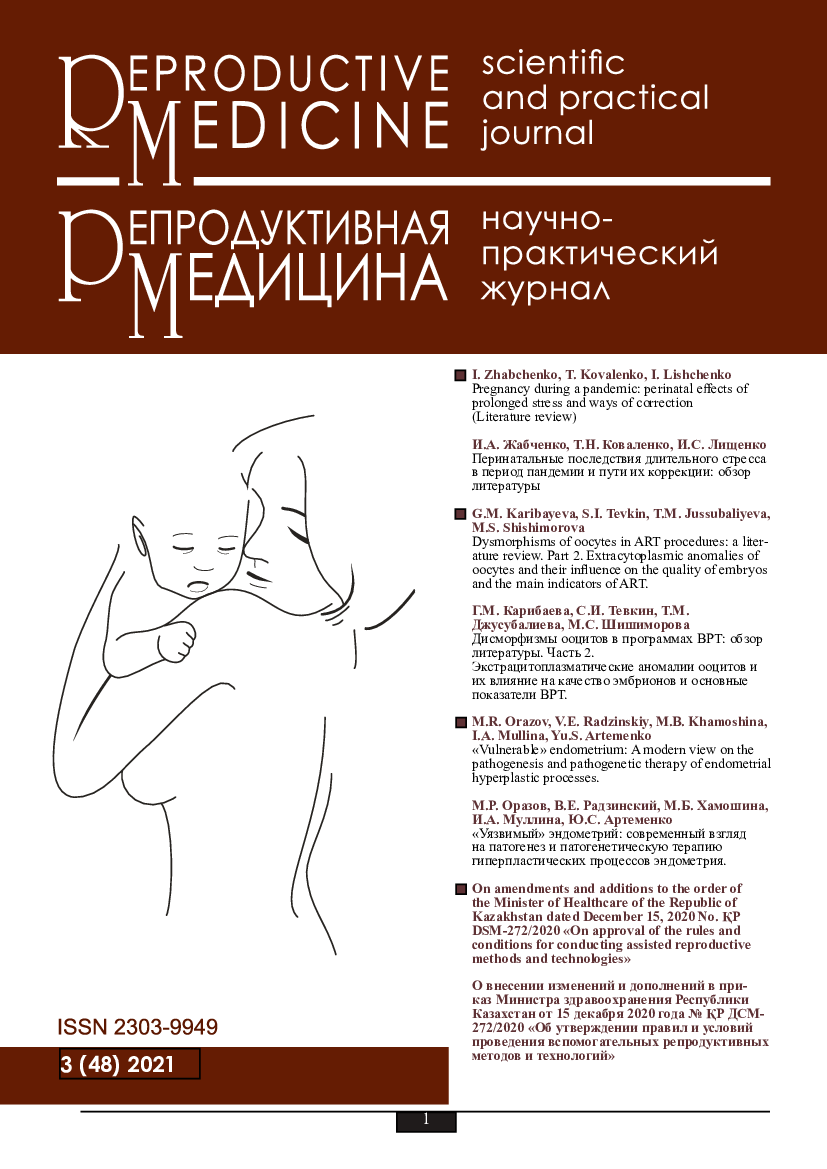Analysis of the platelet hemostasis among pregnant women with immune thrombocytopenia
DOI:
https://doi.org/10.37800/RM.3.2021.61-75Keywords:
thrombocytopenia, pregnancy, immune thrombocytopenia, platelet aggregation, light aggregometryAbstract
Relevance: Thrombocytopenia is a common hematological problem that accompanies pregnancy. From 5% to 12% of pregnancies are complicated by thrombocytopenia. Gestational thrombocytopenia is the leading cause of complications (70-85%). Immune thrombocytopenia (ITP) is the most frequent reason among pre-pregnancy causes of thrombocytopenia and is responsible for 1-4% of all thrombocytopenia cases during pregnancy. Investigation of the functional potential of the thrombocyte link of hemostasis in conditions of a reduced number of thrombocytes is relevant.
The purpose of the study was to analyze the platelet link of hemostasis in pregnant women with ITP of varying severity by the method of light aggregometry.
Materials and Methods: Eighty-eight women with gestational and 28 with immune thrombocytopenia were undergoing treatment and delivery at the Institute of Pediatrics, Obstetrics and Gynecology of NAMS of Ukraine (Kyiv, Ukraine) from September 2018 to February 2021. The platelet link of hemostasis was studied in a group of women with immune thrombocytopenia; six (21.4%) of them had severe thrombocytopenia.
Results: In mild and moderate immune thrombocytopenia, we noted a decrease in spontaneous and induced platelet aggregation; in severe immune thrombocytopenia, there was no spontaneous and a decreased induced platelet aggregation.
Conclusion: Immune thrombocytopenia accounts for most pre-pregnancy conditions causing thrombocytopenia in pregnant women. Light aggregometry is a relevant and indicative way to analyze the aggregative ability of platelets. A multidisciplinary team consisting of an obstetrician-gynecologist, hematologist, anesthesiologist, and neonatologist should be involved in the management of such cases to provide effective obstetric care for this category of pregnant women. Risks for the mother and the fetus/newborn should be assessed throughout the pregnancy, considering clinical and laboratory aspects. Delivery of pregnant women with severe thrombocytopenia should be managed at institutions providing the highest level of obstetric and gynecological care.
References
Pavord S., Hunt B. The Obstetric Hematology Manual. Cambridge University Press, 2010;
Cines D.B., Levine L.D. Blood. 2017; 130(21): 2271-2277. https://doi.org/10.1182/blood-2017-05-781971;
Rajasekhar A., Gernsheimer T., Stasi R., James A.H. Clinical Practice Guide on Thrombocytopenia in Pregnancy. – Washington, DC: American Society of Hematology; 2013.
Reese J.A., Peck J.D., Deschamps D.R., McIntosh J.J., Knudtson E.J., Terrell D.R., Vesely S.K., George J.N. N. Engl. J. Med., 2018; 379: 32-43. https://doi.org/10.1056/NEJMoa1802897;
Provan D., Arnold D.M., Bussel J.B., Chong B.H., Cooper N., Gernsheimer T., Ghanima W., Godeau B., González-López T.J., Grainger J., Hou M., Kruse C., McDonald V., Michel M., Newland A.C., Pavord S., Rodeghiero F., Scully M., Tomiyama Y., Wong R.S., Zaja F., Kuter D.J. Blood Adv., 2019; 3(22): 3780–3817. https://doi.org/10.1182/bloodadvances.2019000812;
Parnas M., Sheiner E., Shoham-Vardi I., Burstein E., Yermiahu T., Levi I., Holcberg G., Yerushalmi R. Eur. J. Obstet. Gynecol. Reprod. Biol., 2006; 128(1-2): 163-168. https://doi.org/10.1016/j.ejogrb.2005.12.031;
ACOG Practice Bulletin No. 207. Obstet. Gynecol., 2019; 133(3): e181-e193. –https://doi.org/10.1097/AOG.0000000000003100;
Fadiloglu E., Unal C., Tanacan A., Portakal O., Beksac M.S. Geburtsh Frauenheilk, 2020; 80: 76-83. https://doi.org/10.1055/a-0865-4442;
Rodeghiero F., Stasi R., Gernsheimer T., Michel M., Provan D., Arnold D.M., Bussel J.B., Cines D.B., Chong B.H., Cooper N., Godeau B., Lechner K., Mazzucconi M.G., McMillan R., Sanz M.A., Imbach P., Blanchette V., Kühne T., Ruggeri M., George J.N. Blood, 2009; 113(11): 2386-2393. https://doi.org/10.1182/blood-2008-07-162503;
Gabbe S.G., Niebyl J.R., Simpson J.L., Landon M.B., Galan H.L. Obstetrics: Normal and Problem Pregnancies, 7th ed. – Elsevier; 2017. – eBook ISBN: 9780323392174;
Sankaran S., Robinson S.E. Obstet. Med., 2011; 4(4): 140-146. https://doi.org/10.1258/om.2011.110025;
Мельник А. Здоров'я України, 2016; 3(376): 56-57. [Melʹnyk A. Zdorov'ya Ukrayiny, 2016 roku; 3 (376): 56-57]. http://health-ua.com/wp-content/uploads/2016/03/56-57.pdf;
Born G.V. Nature, 1962; 194: 927-929.
Harrison P., Keeling D. In: Michelson A.D., ed. Platelets. – San Diego, CA: Elsevier/Academic Press; 2007: 445-474.
Additional Files
Published
How to Cite
Issue
Section
License
The articles published in this Journal are licensed under the CC BY-NC-ND 4.0 (Creative Commons Attribution – Non-Commercial – No Derivatives 4.0 International) license, which provides for their non-commercial use only. Under this license, users have the right to copy and distribute the material in copyright but are not permitted to modify or use it for commercial purposes. Full details on the licensing are available at https://creativecommons.org/licenses/by-nc-nd/4.0/.




